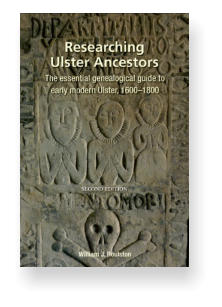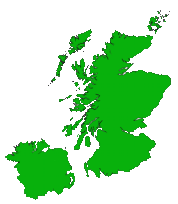Ulster Reading Resources
The Plantation of Ulster:
“In this vivid account, the author punctures
some generally held assumptions: despite
slaughter and famine, the province on the eve
of the Plantation was not completely
depopulated as was often asserted at the time;
the native Irish were not deliberately given
the most infertile land; some of the most
energetic planters were Catholic; and the
Catholic Church there emerged stronger than
before. Above all, natives and newcomers
fused to a greater degree than is widely
believed: apart from recent immigrants, nearly all Ulster
people today have the blood of both Planter and Gael flowing
in their veins. Nevertheless, memories of dispossession and
massacre, etched into the folk memory, were to ignite
explosive outbreaks of intercommunal conflict down to our
own time. The Plantation was also the beginning of a far
greater exodus to North America. Subsequently, descendants of
Ulster planters crossed the Atlantic in their tens of thousands to
play a central role in shaping the United States of America.”
M.C. O’Callaghan’s Using the 1901/1911 Irish Census is a
highly recommended resource, particularly if you are not
familiar with the content of the census and how it can be used.
The amount of information in the 1901/1911 Census is
surprising. Even more interesting is the ability to drill down
and see which townland is included in each District Electoral
Division. The book is available as a Kindle book and is
reasonably priced at $1.32.
A New Genealogical Atlas of Ireland: “a
key resource in Irish genealogical research,
this second edition contains maps detailing the
location of Roman Catholic parishes in all 32
countries of Ireland and Presbyterian
congregations in the nine counties of Northern
Ireland. Information collected here is essential
for tracing pre-1864 ancestors in church
records and useful for locating post-1864
ancestors in civil records, with descriptions and maps of the
parochial and civil administrative divisions to which all major
Irish record sources are linked. To aid researchers in
identifying the precise location of administrative divisions,
there are at least four maps for every county, depicting Church
of Ireland parishes, baronies, and Church of Ireland dioceses,
poor law unions and the parishes included within the probate
districts serving that county, and Roman Catholic parishes and
dioceses.”
The Scottish Migration to Ulster: “was first
published in 1973, yet it continues to be one of
the most significant works of scholarship on the
'plantation' of Ulster. This book describes in
detail the initial establishment of settlement in
Ireland's northern province over a
comparatively short space of time, that is from
1603 to 1625. He examines the society that
produced the Scottish settlers, describes the
conditions that they encountered when they
arrived in Ireland, and explains what effect the Scottish
migration had in both Ireland and Scotland. Short biographies
of the principal planters are included and also maps, showing
patterns of settlement.” It’s also available at the Ulster
Historical Foundation book store.
Researching Ulster Ancestors:
“When the first edition of this book
appeared in 2005 it was quickly
recognised as an essential work of
reference for family historians
researching Ulster ancestors in the
seventeenth and eighteenth centuries. It
filled an important gap in providing
reliable guidance on sources for perhaps
the most critical period in understanding
a family’s links with the north of Ireland.
This is territory where some family
historians fear to tread. But they need not.
This guide opens up avenues for research; drawing attention to
the riches of archives inside and outside of the island of
Ireland, demonstrating the benefit of often undervalued, rare,
even quite unconventional, yet accessible sources – if you
know where to look – which can help document your ancestors
back to the 1600s.”
Researching Presbyterian Ancestors in
Ireland: “Millions of people around the
world have Presbyterian ancestors from
Ireland. The aim of this book is to help
those with Irish Presbyterian roots find out
more about their forebears. It considers the
different strands of Presbyterianism in
Ireland and explores the range of records
generated by these religious denominations
and where this material can be accessed by
researchers. Much attention is focused on the documentation
created by individual congregations, though consideration is
also given to the records created by the higher courts of
Presbyterianism and other bodies, as well as the personal
papers of Presbyterian ministers.”
First published in 1966, R. J. Dickson’s
Ulster Emigration to Colonial America,
1718-1775 “remains the acknowledged work
of scholarship on migration in the eighteenth
century of a quarter of a million people from
Ulster to the New World. It combines detailed
investigation of the economic, social, and
political background to the exodus with
information on the emigrant trade and an
analysis of the motivations and origins of the
emigrants themselves. This new edition
includes a specially written introduction by Graeme Kirkham,
whose researches on both sides of the Atlantic are reflected in
an essay which considers recent advances in the understanding
of this important mass population movement from Ireland to
America.”
Colonial Ulster , the Settlement of East Ulster 1600 - 1641:
“In this Landmark Raymond Gillespie
reconstructs the society of east Ulster –
the counties of Antrim and Down – in
the early seventeenth century. These
counties formed a distinct region within
Ulster and were excluded from the
official scheme for the Ulster plantation.
In remarkable detail – all the more
impressive due to the loss of so many
records of this era – the author explores
demographic and economic
developments, the emergence of rural and
urban communities, and the tension between central
government and local interests. In doing so, he reveals a
fascinating picture of the strivings of both settlers and natives
to establish a modus vivendi during a period of rapid change.”
Strabane Barony during the Ulster
Plantation: “Under the scheme of
Plantation, Strabane barony was allocated to
undertakers from Scotland, the chief of
whom was James Hamilton, 1st Earl of
Abercorn. The settlement here was therefore
overwhelmingly Scottish, rather than
English. Chapters in this book look at
Strabane in the pre-Plantation era, the
background of the Scottish undertakers, the
development of the town of Strabane, the
impact of the Reformation, and the socio-economic conditions
prevailing in the barony in the early seventeenth century. First
published over 30 years ago, this fresh edition of The Strabane
Barony during the Ulster Plantation, 1607-41 presents to a new
audience the story of the Plantation in the barony of Strabane.
It stands as an exemplar of the way in which a professional
historian and his students can successfully work together to
produce a high-quality publication.“
A Narrow Sea:“Based on the popular BBC
Radio Ulster series of the same name,
traces the epic sweep of Ireland’s
relationship with Scotland, exploring the
myriad connections, correlations,
personalities and antagonisms that have,
over the years, defined the relationship
between these two spirited neighbours.
Roving freely across the centuries, from the
first migrations of the regions’ intrepid
Mesolithic pioneers, to the grand colonial
projects of the Vikings, Normans and Stuarts, this is the
dramatic story of how one culture came to found two very
different nations and, in doing so, project its influence as far
afield as North America and Australasia. In 120 brief and
accessible episodes, A Narrow Sea offers a stirring and
panoramic view of a connection that has shaped the course of
history on both sides of the narrow sea.”










The Miller Surname Study

GeoGenealogy













